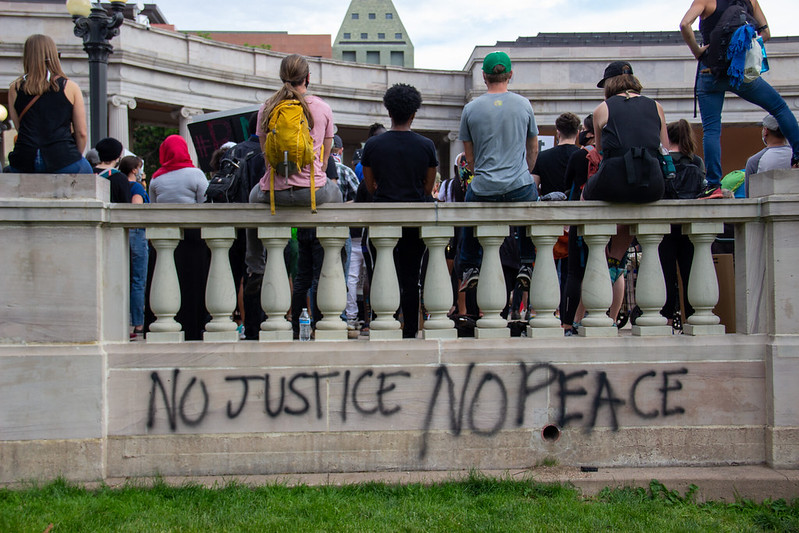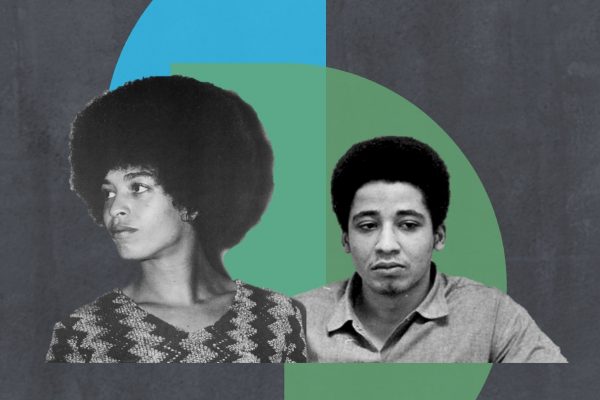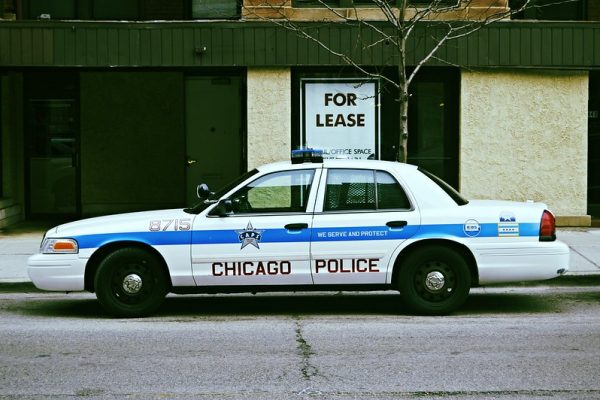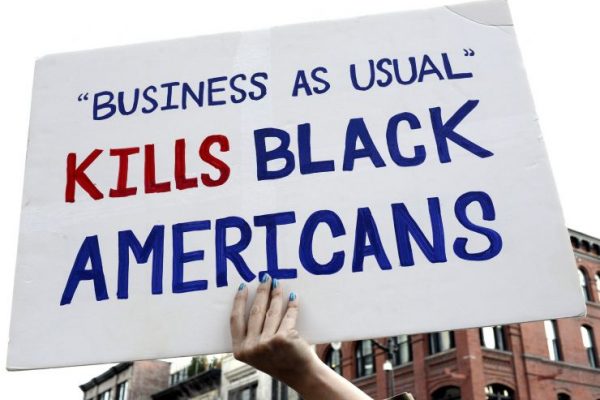In his first speech as president-elect, Joe Biden emphasized the need for national unity and healing. Kamala Harris echoed that sentiment in a tweet November 13: “Now the hard work, the necessary work, the good work begins,” she wrote: “to unite our country and heal the soul of our nation.” Yet evidence of the depth of existing divisions has only increased since Election Day, culminating in the violence at the Capitol we witnessed earlier this month. In the face of this democratic crisis, what exactly—if anything—will enable Americans to unite and heal?
One common response is to focus squarely on the future and attempt to put the past behind us. Dwelling on the past would only sow further division, on this line of thought. This has been the dominant attitude throughout U.S. history, from settler colonialism and slavery, the Civil War, and Jim Crow to the Vietnam War and the Iraq War. Yet there has always been a strain of American thought that contests these efforts to forget the past, and we hear echoes of that tradition in the present moment.
What exactly—if anything—will enable Americans to unite and heal?
A growing chorus of voices, for example, now insists that we hold Trump and members of his administration accountable for pressuring elected officials to change vote tallies, for political corruption, and for his child separation policy at the border. Likewise, calls to invoke the 25th Amendment and impeach Trump followed the mob violence at the Capitol. As so many have pointed out, however, too exclusive a focus on Trump risks treating his administration as an abnormality of U.S. history rather than as a product of conditions that preceded him and that will surely persist when he is no longer in office. Perhaps most familiar among the larger targets of reckoning is the long legacy of racial injustice. As was once again on display last summer, arguably the largest protest movement in U.S. history, Black Lives Matter, has long demanded accountability for police violence and for generations of racial injustice, from slavery to the present day.
This essay is featured in Repair.
This impetus to dig deep into our past is one we should heed: as a society we need to look back first if we are to be able to move forward. This is not only a matter of political strategy in the quest for a just society. It is also a central insight of the ethical framework known as transitional justice, an overlooked but essential resource in the effort to secure the integrity and legitimacy of American democracy.
Transitional justice is both a legal and philosophical theory and a global practice that aims to redress wrongdoing, past and present, in order to vindicate victims, hold perpetrators to account, and transform relationships—among citizens as well as between citizens and public officials. Though it is not as well known in the United States as other paradigms of justice, the framework has been adopted in dozens of countries emerging from periods of war, genocide, dictatorship, and repression, from South Africa to Colombia. As a global practice, the framework began with the recognition that simply moving on hadn’t worked.
From the vantage of transitional justice, healing of communities can only occur if we first understand what is damaged, and damage can only be repaired if it is truly acknowledged and addressed. And to help to prevent recurrence of atrocity, we need to draw a line between what was accepted in the past and what will be acceptable in the future. The particular measures used to achieve these aims have ranged from truth commissions and criminal investigations and prosecutions to reparations, lustration (vetting government officials for ties to repressive regimes or activity), and other legal and institutional changes.
To illustrate how transitional justice differs from other frameworks of justice, consider restorative justice, which prioritizes the repair of ruptured relationships among victim, offender, and community caused by wrongdoing. Repair occurs via a model of amends—characteristically via apology and reparations—followed by forgiveness.
Perhaps the greatest problem with restorative justice is that it implicitly assumes there is a shared, morally defensible framework and standards for social interaction already in place.
Perhaps the greatest problem is that this framework implicitly assumes that there is a shared, morally defensible framework and standards for social interaction already in place. While it may offer valuable guidance for how to respond to wrongful, one-off interactions measured against these standards, it offers flawed guidance for dealing with systemic problems. To see this, consider how forgiveness looks in the context of abusive relationships. To urge victims of domestic violence to forgive—and to let go of their anger—risks encouraging them to capitulate to their own abuse, failing to take seriously the claim the victim has to better treatment, and overlooking the core problem: the abusive terms structuring the relationship itself. Likewise, forgiveness and isolated instances of victim compensation and perpetrator punishment do nothing to change the sources of racial oppression, including—but hardly limited to—racial disparities in health and health care, the persistence of the racial wealth gap, and racially disproportionate police violence.
Transitional justice also distinguishes itself from retributive justice, which demands the punishment of perpetrators of wrongdoing. Theories of retributive justice typically begin with the assumption of state legitimacy and address how the intentional infliction of punishment is compatible with a state’s recognition of the equality of all citizens. By contrast, in transitional contexts the question is how to establish the legitimacy of the state and the baseline equality of all citizens in the first place. Retributive theories do not tell us how punishment can do this.
Instead of trying to use familiar theories of justice to deal with systemic wrongdoing, we should instead view transitional justice as a distinctive and irreducible solution. The aim of transitional justice is to fundamentally alter the basic terms of interaction, both horizontally among citizens and vertically between citizens and officials. The ultimate goal of dealing with past wrongdoing is not only to satisfy the moral claims of victims and to hold perpetrators to account. It is also to contribute to the transformation of a society so that systemic wrongdoing occurs “never again.” For such change to be effective, it must be based on an accurate understanding of the root problems with relationships among members of society. And relationships can be transformed only if we first understand the conditions that enabled injustice to persist and how past wrongs affect present interaction.
What transitional justice looks like, in practice, has evolved over the past few decades. Colombia provides a helpful illustration. In September 2016 the Colombian government and the Revolutionary Armed Forces of Colombia-People’s Army (FARC) signed a historic Final Agreement to End the Armed Conflict and Build a Stable and Lasting Peace (Final Agreement), ending more than fifty years of armed conflict. A modified version of the agreement was ratified by the Colombian Congress in November of that year. The terms of the Final Agreement included explicit provisions for dealing with a variety of wrongdoing committed during the course of the conflict as well as the root causes of the conflict itself. The toll of the conflict was significant: millions forcibly displaced, hundreds of thousands killed, tens of thousands more kidnapped, tortured, or disappeared. Transitional justice processes in the country include a truth commission charged with investigating and explaining the armed conflict, reparations, Special Unit on the Search for Persons Deemed as Missing, and the Special Jurisdiction for Peace (JEP).
The aim of transitional justice is to fundamentally alter the basic terms of interaction, both horizontally among citizens and vertically between citizens and officials.
Truth commissions like this one are official bodies established with a mandate to document the occurrence, causes, and consequences of specified human rights violations committed over a delimited period of time. Most commissions also make recommendations for how to prevent similar violations in the future. They collect testimony from witnesses, review documents, and visit sites of violence and typically operate in contexts where the extent of, responsibility for (both individual and institutional), and victims of human rights violations are unclear. Truth commissions provide an official record of violations, establishing the truth about the identity and fate of victims and survivors, the identity of perpetrators, and the causes of wrongdoing.
The JEP, meanwhile, is a set of judicial bodies investigating perpetrators of political crimes such as rebellion as well as war crimes and crimes against humanity. A notable feature of these processes is their wide range of forms of accountability. Perpetrators who confess to political crimes such as rebellion are eligible for amnesty, while those who committed gross human rights violations such as war crimes and crimes against humanity, for political reasons and not for personal enrichment, face a scale of sanctions. Those who fully and immediately confess are eligible to serve five to eight years in zones of restricted liberty—a penalty that is explicitly framed as having a restorative rather than retributive function. Perpetrators who confess after JEP proceedings have begun face five to eight years in prison, however, and those who do not confess but are ultimately convicted face fifteen to twenty years of imprisonment. Beyond these specific mechanisms, there are provisions for integrating former FARC combatants and for integrating the post-FARC political party through guaranteed political representation in Congress through 2026. There is also a commitment to rural development to address the root causes of conflict and inequality in Colombian society.
What is notable about the Colombian case is that its set of processes for dealing with wrongdoing jointly pursue the central pillars of transitional justice: truth, justice (in the form of accountability), reparations, and institutional reform. Rather than framing the choice between a truth commission and a criminal trial in oppositional terms, the processes are designed to be complementary. Transitional justice theory and practice no longer view the choice societies must face as one between truth and justice but as one that pursues truth and justice in tandem. It is important both to tell the truth—to document the pattern and extent of human rights violations and the conditions that enabled their occurrence, as the Colombian truth commission does—and to achieve justice: to hold perpetrators to some kind of account, as the JEP aims to achieve.
The Colombian case also illustrates the profoundly fragile political contexts in which transitional justice is typically pursued. The current president, Iván Duque Márquez, was elected in 2018 on a presidential platform explicitly opposed to specific aspects of the Final Agreement. In particular, he viewed the JEP as failing to achieve a sufficient level of accountability for FARC combatants. Duque’s election reflects the fact that the practices of transitional justice are always inherently political. Particular mechanisms of transitional justice are controversial and contestable in part because they are necessarily imperfect. Not all perpetrators and victims are addressed; those who are will almost certainly not see perfect justice; nor are perpetrators punished commensurate with what retribution would seem to mandate or deterrence would seem to require. But the perfect should not be the enemy of the good, and transitional justice is the best solution we have for achieving a fundamental transformation of social and political relationships after systemic wrongdoing.
The idea that the same framework for healing conflict-torn Colombia should be implemented in the United States is sure to strike many Americans as implausible. Underpinning this skepticism is often a distinctive form of American exceptionalism. In defining away any wrongdoing as “un-American,” or in limiting its range to outright civil war or widespread armed conflict, such reactions obscure distinctively American failures, obscure the need for distinctively American change, and prevent us from learning from other countries. Reckoning with American injustice requires humility and a willingness to be open to the possibility that we could have done—and should now do—better. Transitional justice offers a global and comparative lens through which to situate problems specific to the United States and from which to evaluate proposed solutions.
Defining any wrongdoing as “un-American” obscures distinctively American failures, obscures the need for distinctively American change, and prevents us from learning from other countries.
To some extent, the 2020 elections and Trump era have blunted that sense of exceptionalism. Moreover, amidst widespread disagreement about just about everything, few Americans would dispute the claim that our society is characterized by deep, and deepening, political divisions. Our institutional fragility creates precisely the kind of serious existential uncertainty characteristic of transitional contexts.
Yet exceptionalism persists and was on display in many reactions to the storming of the Capitol, which emphasized that “this is not who we are” and characterized the violence as a feature of “banana republics” or the “Third World.” Of a piece with such reactions is a common conflation of our ideals with our practice, which is then used to discredit any proposed critique. To focus on where we have, in fact, done wrong or failed to live up to our ideals as a nation is not to reject those ideals; indeed, very often the ideals themselves provide the basis for explaining our failure. Pointing this out is not to reject our ideals, but rather to reject American acts that do not live up to them.
Once we set such exceptionalism aside, we are prepared to see that the similarities between the United States and other transitional contexts run deep indeed. (In fact, aspects of transitional justice already have a history in certain U.S. contexts, such as the national Commission on Wartime Relocation and Internment of Civilians, carried out in the 1980s to address the interment of Japanese Americans during World War II, and the Illinois Torture Inquiry and Relief Commission, initiated in 2009 to respond to decades of torture enacted by Chicago Police.) Deciding whether transitional justice is necessary for a community requires examining what I call “the circumstances of transitional justice.” Transforming political relationships becomes morally necessary and is practically possible under these circumstances.
One circumstance is serious existential uncertainty, which captures the fragility of political contexts in which the political future becomes profoundly unclear. Against the background of unfounded challenges to the 2020 election results and Capitol riots, for example, peaceful and democratic transitions of power are no longer a given. Moreover, like other paradigm transitional societies, the United States is also marked by pervasive structural inequality, in our context heavily shaped by race. Structural inequality explains how certain groups of citizens are disproportionately unable to avoid poverty, participate in political and economic processes, or shape the rules and norms for interaction. Structural inequality runs deep both throughout U.S. history and the present day, from the persisting racial wealth gap that remains basically unchanged since the end of Jim Crow to the long history of voter suppression and disenfranchisement targeting Black citizens and the disproportionate burden of COVID-19 in terms of mortality and job loss and borne by Black and Indigenous people.
The third key circumstance is normalized political wrongdoing: when human rights violations perpetrated by state actors become a basic fact of life for members of certain groups. The racially disproportionate effects of police violence are just one such case. Though they make up only 13 percent of the population, Black Americans make up more than 25 percent of police shooting victims. Pervasive structural inequality and normalized political wrongdoing make the transformation of political relationships among citizens and between citizens and officials morally necessary.
Of course, just because we need transitional justice in the United States in no way guarantees we will pursue it. Efforts to downplay or sideline concerns with the historical and abiding injustices perpetrated against various marginalized communities—especially communities of color—pose one of the greatest obstacles to national unity. To understand how to combat denial, we need first to understand the forms it takes.
Efforts to downplay and sideline concerns with injustices perpetrated against communities of color pose one of the greatest obstacles to national unity.
In his 2001 study States of Denial: Knowing about Atrocities and Suffering, psychologist Stanley Cohen identifies three forms of denial of injustice can take. The first is literal denial, where basic facts are disputed. Consider Trump’s 2020 Presidential Executive Order 13950 and a follow-up Memo from the Executive Branch Office of Management and Budget to heads of Executive Departments and Agencies. Both engage in literal denial by suggesting that discussion of any racism or evil actions in our past is “propaganda.” (The memo makes this suggestion explicit.) More specifically, EO 13950 characterizes as mere ideology the claim that America “is grounded in hierarchies based on collective social and political identities rather than in the inherent and equal dignity of every person as an individual.” It stipulates as false that anyone on the basis of their race could oppress or benefit from racialized segregation or slavery, contending that such ideas are grounded in a “destructive ideology” and “misrepresentations of our country’s history and its role in the world.”
The second form Cohen discusses is interpretive denial, where an act or state of affairs that is wrong is re-described so as to downplay wrongfulness. A striking example is Senator Tom Cotton’s recently characterization of slavery as a “necessary evil.” Cotton’s words capture a common view among conservatives, downplaying the gravity of the wrong of slavery and implicitly seeking to justify, rather than repudiate, that part of our nation’s history. Likewise, the New York Times’s 1619 Project, which “aims to reframe the country’s history by placing the consequences of slavery and the contributions of black Americans at the very center of our national narrative,” generated pushback that went beyond scholarly disputes to call into question the legitimacy of centering Black lives and experiences and centuries of slavery. This extreme form of repudiation is different in kind from the criticism about specific conclusions or pieces of evidence to which any research project is rightly subject; it reflects a form of interpretive denial regarding the significance and centrality of white supremacy and racial injustice in the United States.
The third form of denial Cohen calls “implicatory”: acknowledging something is happening but refusing to acknowledge its significance. Wrongdoing may become so normalized that it is no longer the subject of outrage. Other forms of implicatory denial involve a rejection or displacement of responsibility for wrongdoing. Following the mob attack on the Capitol, for example, many in conservative media shifted responsibility from Trump supporters to outside “agitators” who “don’t look like Trump supporters.”
All three forms of denial are examples of what philosopher Tommie Shelby calls ideological racism, in which commonly held beliefs and judgments distort social reality in ways that lead to enduring injustice in social relationships. As Cohen explains, official denial is successful only when there is a willing audience. “Denials draw on shared cultural vocabularies to be credible,” he writes. “They may also be shared in another powerful sense: the commitment between people—whether partners (folie à deux) or an entire organization—to back up and collude in each other’s denials.” Such denial, undergirded by white anxiety, has deepened and worsened during the Trump presidency, but its roots stretch back throughout U.S. history. The most effective way to counter these insidious forms of denial is to embrace the practices of transitional justice. As Wesley Morris wrote in the New York Times last July:
This Moment of historic holding to account, of looking inward, deserves a commensurate, totalizing event that explains what is being reckoned with, demanded and hoped for, an experience that rubs between its fingers the earth upon which all those toppled monuments had so brazenly stood. The Moment warrants a depth of conversation the United States has never had. It demands truth and reconciliation. . . . Truth and reconciliation is a death and a birth, accordingly arduous, tense, procedural, affirming, painful. . . . The Moment demands that we summon the courage to put ourselves through it. At last.
For all these reasons, there is growing emphasis among scholars and practitioners of transitional justice that it is urgently needed in the United States. Measures taken in recent years parallel that growing consensus, from the Maine Wabanaki-State Child Welfare Truth & Reconciliation Commission (which operated from 2013 to 2015) to the Equal Justice Initiative’s National Memorial for Peace and Justice (which opened in 2018 in Montgomery, Alabama) and the Maryland Lynching Truth and Reconciliation Commission (established in 2019 by House Bill 307), to New York City’s Racial Justice and Reconciliation Commission and a reparations program for Black residents passed by the city council of Asheville, North Carolina, both launched last summer.
The design and implementation of concrete measures of transitional justice must be informed by scholars, activists, practitioners, and members of affected communities.
As these calls and efforts grow, the scope of U.S. transitional justice—the specific wrongs it confronts—as well as the design and implementation of concrete measures must be informed by a variety of stakeholders, including scholars, activists, practitioners, and members of affected communities. On the issue of racial justice specifically, it is critical that scholarship merge two complementary sources of insight that are rarely in conversation: the scholarship on civil rights and Black political thought, on the one hand, and scholarship on transitional justice, on the other. Context shapes what processes are most needed and what form measures like truth commissions should take. Deep, context-specific knowledge is critical to developing appropriate and effective responses to racial injustice. For more than a century scholars of civil rights and Black political thought have diagnosed the sources of racial injustice economically, politically, and in terms of criminal justice in the United States. They have outlined mechanisms for its redress, including but not limited to reparations. Deep knowledge of how racial injustice operates and the form it takes is essential for developing prescriptions that will address how our relationships are damaged and the consequences of the specific form wrongdoing has taken and currently takes.
At the same time, we must bear in mind that there is no simple formula for what set of processes should be used to pursue transitional justice. Nor is there a short and simple route to success in transforming political relationships. Empirical research documents the tangible impact measures such as truth commissions, lustration, and institutional reform can have in contributing to democratic stability and providing a foundation for building more just societies. Such research also underscores limitations in the existing transitional justice practice in dealing with structural and racial injustice, which the United States must avoid. Most fundamentally, transformational change is a generational project requiring ongoing political will beyond the mandate of specific transitional justice processes, as the experience in Germany shows. A single truth and reconciliation commission cannot by itself transform the lives of marginalized and victimized individuals and political relationships more broadly. Transformation requires multiple processes and robust institutional reform.
Transitional justice provides the necessary resources to reckon honestly with American wrongdoing—and to help transform our society in ways that finally live up to the ideals we profess.
However these practices ultimately take shape, it is essential that we begin to have these conversations among the necessary stakeholders and at the highest levels of government, now. A national framework for transitional justice is needed to complement isolated local efforts, both those to come and those already underway. To facilitate this, Biden and Harris could establish a commission on transitional justice and build a relationship with the United Nations Special Rapporteur on the promotion of truth, justice, reparation and guarantees of non-recurrence. We must acknowledge that decades of efforts to put the past behind us have failed. Far from a framework applicable only elsewhere, transitional justice provides the necessary resources to reckon honestly with American wrongdoing—and to help transform our society in ways that finally live up to the ideals we profess.








